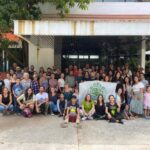by Dr. J. Robin Moon, Head of Strategy, WorldFMC
On June 20, I represented WorldFMC and spoke at the “Advancing Food Is Medicine Approaches” Summit in Boston, of Food Tank, the White House, and the Friedman School of Nutrition Science and Policy. This event in the Summit series was held in support of the Biden-Harris Administration’s National Strategy on Hunger, Nutrition, and Health.
The “food as medicine” concept is from Hippocrates in 400 B.C., who said, “Let food be thy medicine and medicine be thy food.” We know that food is fundamental to health and that many traditional cultures throughout human history have upheld this healing nature of food.
Food is Medicine (FIM) as we know it today is relatively new in the last few years in the US and has gotten a significant spotlight since the pandemic. It refers to a set of food-based nutrition interventions integrated into the healthcare system to treat or prevent chronic diseases. Simply put, it sits at the crossroads of nutrition and healthcare. It includes medically tailored meals and groceries, and produce prescription programs.
I know firsthand how vital this work is. I spent seven years (2014 – 2021) as one of the key decision-makers and implementers of New York state-wide Medicaid reform. My focus was the Bronx, the poorest of New York City’s five boroughs, which ranks 62 out of 62 counties of New York State in health ranking. Almost 40% of the Bronx children were starving pre-pandemic. And I’ve seen how essential it was for Medicaid to prioritize food as a key social determinant of health. I also wrote about how this syndemic1 of food security, diet-related diseases (DRD), and COVID-19 destroyed the population’s physical and mental health exponentially. I applaud the FIM approach and its evidence of success.

At this Summit, I shared key considerations in thinking about how to scale this work and further its research.
Equity vs. Efficiency. FIM is said to be centered in health equity. But we must intentionally and continually pursue it, as it is not structurally inherent. Our economy (and food system) is one of hyper-efficiency. The Green Revolution of the 1950s was created to pursue efficiency, and its ill consequence includes the grave current state of the worldwide diet and health. Efficiency and equity must be balanced, and we cannot achieve both maximal efficiency and equity – it takes multi-sector, interdisciplinary efforts and accountability.
Context Matters. For the population segment with a critical need for medically tailored food to address their metabolic issues, evidence shows that FIM is life-saving. A larger proportion of the food-insecure (and chronically ill) population is not in this category. The clinical evidence for the former, devoid of the socioeconomic context, is not applicable for the latter, nor is the evidence predictable of sustained success. If we only consider our society’s syndemic in isolation, we run a risk of being reductionist and deficit-based. This risk is very expensive and can be wasteful – why is it up to medicine to fix the problem? I don’t think Hippocrates meant nutritional intake only in terms of “food as health,” but also holistic, communal well-being.
Behavioral Change Is A Complex Process. Our hypothesis that offering healthier food access solves their problem is naïve, even paternalistic. We must start with compassion and respect, not judgment. People make the smartest choice they can, given the context of their social determinants. While access to healthier food is the absolutely necessary first step, we must recognize that sustained human behavior change is complex. Such change happens not from incentive programs alone, nor from education and new recipes alongside. It happens over time, through interactions with community members they trust, with cultural humility and sensitivity, and when contextualized for the person’s and family’s physical and social environments. This includes being able to shop for the food they like (at the times they can), to cook it the way they like and rooted in their identity, to enjoy eating it with their family and community, to start seeing health improvement, and then to repeat this process sustainably.
This requires more evidence-gathering beyond the nutritional efficacy and clinical outcomes of FIM, but also in understanding how long-lasting behavior change can happen. New measures include the food environment and exposure, change in diet patterns and food preferences over time, ways to help maintain new behavior, cultural appropriateness, and elements that meaningfully lower barriers. Funding also needs to be for a longer time and with a broader scope.
WorldFMC upholds WHO’s definition of health as a state of complete physical, mental, and social well-being and not merely the absence of disease or infirmity. In advancing FIM, we see our unique and complementary role clearly: we place farmers markets in the center of our food system, locally and globally, reconnecting food producers, consumers, and communities, and restoring food security, dignity in eating, community trust, and population health. We are grateful for Food Tank’s partnership and foresight to include WorldFMC in this conversation.

Follow this link for a full recording of the conference.
Footnotes:
- Two or more epidemics interacting synergistically and contributing, as a result of their interaction, to excess burden of diseases in a population.
J. Robin Moon, DPH, MPH, MIA, is a transdisciplinary scholar in social epidemiology, a practitioner and entrepreneur of health equity and health justice, and an educator in public health. She is the head of strategy at the World Farmers Markets Coalition.






